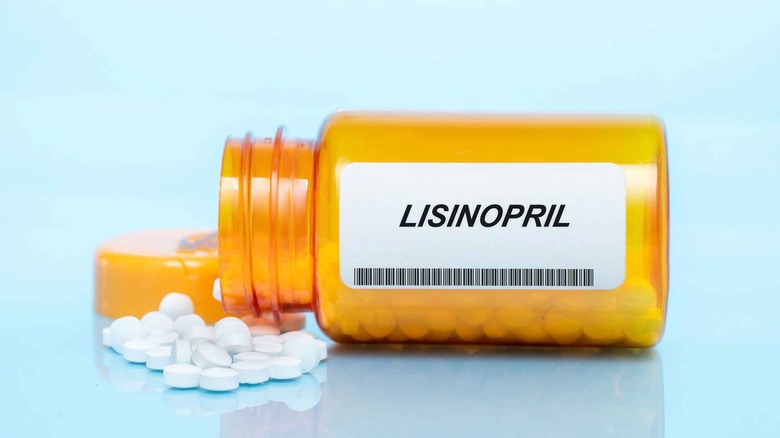This Is How Long It Takes For Lisinopril To Start Working
In order to treat high blood pressure, most take lisinopril, an angiotensin converting enzyme (ACE) inhibitor, as per Drugs.com. High blood pressure is a major health concern characterized by stiffened arteries (via The National Institute on Aging). People with high blood pressure have a systolic pressure of 130 and above or a diastolic pressure of 80 or higher. The condition affects nearly half of all adults — many who don't know they have the condition until it's too late. This elusiveness gives the condition the popular moniker "the silent killer." Keep in mind, hypertension is a leading condition, killing about 10 million people annually, according to the World Heart Federation. However, it is a preventable risk factor for cardiovascular disease.
Although there is no cure for high blood pressure, various treatment options exist to reduce the risk of critical hypertensive symptoms (via the National Kidney Foundation). That's where lisinopril comes in. As an ACE inhibitor, lisinopril relaxes and widens your blood vessels if you have hypertension, making it easier for your heart to pump blood around your body, per the National Health Service (NHS). However, if you've been prescribed this medication, you might wonder how long it takes for lisinopril to start working.
It could take hours, weeks, or months
Lisinopril usually works very quickly, but its efficiency might vary from one person to another (via Drugs.com). Some people may experience an immediate drop in blood pressure after taking their first dose of lisinopril. Others might need more time to experience a reduction in high blood pressure. However, the drug's full effect may not actualize until a few weeks (per NHS). Lisinopril's onset of action may also vary depending on the health condition. For example, it may take several weeks or even months to feel better if you take lisinopril for heart failure. You may not even notice a difference in some cases, but this doesn't mean the drug is ineffective or you should stop taking it. It's important to stick to your doctor's prescriptions or speak to your doctor if you feel no effect.
Your doctor might prescribe a dose based on your condition or response to treatment. As a guide, however, 10 mg of lisinopril solution or a daily tablet once per day is recommended for adults with high blood pressure, according to the Mayo Clinic. Luckily, it can also be taken with or without food (via WebMD). Nonetheless, it's important to use the special spoon or device supplied with the medication. This will ensure you're not going below or beyond the required dose.
Common side effects of lisinopril
Similar to most blood pressure medications, lisinopril comes with various side effects. However, many people only experience minor ones or have none at all, explains NHS. These side effects occur in more than 1 in 100 people and usually include headaches, itchy skin, dizziness, diarrhea, vomiting, and a dry cough that doesn't improve. Some side effects may disappear as your body adjusts to the drug. However, others may need immediate medical attention.
A handful of people taking lisinopril might even experience a decreased interest in sexual intercourse, and loss of sexual ability or drive, according to the Mayo Clinic. Other rare side effects include indigestion, muscle cramps, belching, and swelling.
As for severe side effects, they include tiredness, weight gain, elevated liver enzymes, and yellowing of your skin, among others (per Healthline). Some may go as far as experiencing arrhythmia, which is usually caused by abnormally high potassium levels in the body.



